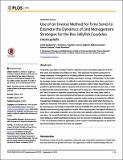Por favor, use este identificador para citar o enlazar a este item:
http://hdl.handle.net/10261/124249COMPARTIR / EXPORTAR:
 SHARE SHARE
 CORE
BASE CORE
BASE
|
|
| Visualizar otros formatos: MARC | Dublin Core | RDF | ORE | MODS | METS | DIDL | DATACITE | |

| Campo DC | Valor | Lengua/Idioma |
|---|---|---|
| dc.contributor.author | Bordehore, Cesar | - |
| dc.contributor.author | Fuentes, Veronica | - |
| dc.contributor.author | Segarra, José G. | - |
| dc.contributor.author | Acevedo, Melissa | - |
| dc.contributor.author | Canepa, Antonio | - |
| dc.contributor.author | Raventós, José | - |
| dc.date.issued | 2015-09-16 | - |
| dc.identifier | issn: 1932-6203 | - |
| dc.identifier | e-issn: 1932-6203 | - |
| dc.identifier.citation | PLoS ONE 10(9): e0137272 (2015) | - |
| dc.identifier.uri | http://hdl.handle.net/10261/124249 | - |
| dc.description | 14 pages, 6 figures, 2 tables, supporting Information https://doi.org/10.1371/journal.pone.0137272 | - |
| dc.description.abstract | Frequently, population ecology of marine organisms uses a descriptive approach in which their sizes and densities are plotted over time. This approach has limited usefulness for design strategies in management or modelling different scenarios. Population projection matrix models are among themost widely used tools in ecology. Unfortunately, for the majority of pelagic marine organisms, it is difficult to mark individuals and follow themover time to determine their vital rates and built a population projectionmatrixmodel. Nevertheless, it is possible to get time-series data to calculate size structure and densities of each size, in order to determine the matrix parameters. This approach is known as a “demographic inverse problem” and it is based on quadratic programming methods, but it has rarely been used on aquatic organisms.We used unpublished field data of a population of cubomedusae Carybdea marsupialis to construct a population projection matrix model and compare two different management strategies to lower population to values before year 2008 when there was no significant interaction with bathers. Those strategies were by direct removal of medusae and by reducing prey. Our results showed that removal of jellyfish fromall size classes was more effective than removing only juveniles or adults.When reducing prey, the highest efficiency to lower the C. marsupialis population occurred when prey depletion affected prey of all medusae sizes. Our model fit well with the field data and may serve to design an efficient management strategy or build hypothetical scenarios such as removal of individuals or reducing prey. TThis This sdfsdshis method is applicable to othermarine or terrestrial species, for which density and population structure over time are available | - |
| dc.description.sponsorship | This research was carried out under contract LIFE 08 NAT ES 0064 (to CB and VLF) cofinanced by the European Commission (www. cubomed.eu), the Ministerio de Agricultura, Alimentación y Medio Ambiente, the Dirección General del Agua of the Regional Government of Valencia and the Fundación Biodiversidad. This work was also partially supported by Spanish Ministry of Education and Science co-funded by FEDER This research was carried out under contract LIFE 08 NAT ES 0064 (to CB and VLF) cofinanced by the European Commission (www.cubomed.eu), the Ministerio de Agricultura, Alimentación y Medio Ambiente, the Dirección General del Agua of the Regional Government of Valencia and the Fundación Biodiversidad. This work was also partially supported by Spanish Ministry of Education and Science co-funded by FEDER | - |
| dc.publisher | Public Library of Science | - |
| dc.relation.isversionof | Publisher's version | - |
| dc.rights | openAccess | - |
| dc.title | Use of an Inverse Method for Time Series to Estimate the Dynamics of and Management Strategies for the Box Jellyfish Carybdea marsupialis | - |
| dc.type | artículo | - |
| dc.identifier.doi | 10.1371/journal.pone.0137272 | - |
| dc.relation.publisherversion | https://doi.org/10.1371/journal.pone.0137272 | - |
| dc.date.updated | 2015-11-02T09:45:20Z | - |
| dc.description.version | Peer Reviewed | - |
| dc.language.rfc3066 | eng | - |
| dc.rights.license | https://www.plos.org/open-access/ | - |
| dc.contributor.funder | Ministerio de Educación y Ciencia (España) | - |
| dc.contributor.funder | Fundación Biodiversidad | - |
| dc.contributor.funder | Generalitat Valenciana | - |
| dc.contributor.funder | European Commission | - |
| dc.contributor.funder | Ministerio de Agricultura, Alimentación y Medio Ambiente (España) | - |
| dc.relation.csic | Sí | - |
| dc.identifier.funder | http://dx.doi.org/10.13039/501100003359 | es_ES |
| dc.identifier.funder | http://dx.doi.org/10.13039/501100000780 | es_ES |
| dc.identifier.funder | http://dx.doi.org/10.13039/501100004336 | es_ES |
| dc.identifier.pmid | 26376483 | - |
| dc.type.coar | http://purl.org/coar/resource_type/c_6501 | es_ES |
| item.openairetype | artículo | - |
| item.grantfulltext | open | - |
| item.cerifentitytype | Publications | - |
| item.openairecristype | http://purl.org/coar/resource_type/c_18cf | - |
| item.fulltext | With Fulltext | - |
| Aparece en las colecciones: | (ICM) Artículos | |
Ficheros en este ítem:
| Fichero | Descripción | Tamaño | Formato | |
|---|---|---|---|---|
| .Bordehore_et_al_2015.pdf | 1,03 MB | Adobe PDF |  Visualizar/Abrir |
CORE Recommender
PubMed Central
Citations
3
checked on 22-mar-2024
SCOPUSTM
Citations
5
checked on 17-abr-2024
WEB OF SCIENCETM
Citations
5
checked on 28-feb-2024
Page view(s)
297
checked on 23-abr-2024
Download(s)
204
checked on 23-abr-2024
Google ScholarTM
Check
Altmetric
Altmetric
Artículos relacionados:
NOTA: Los ítems de Digital.CSIC están protegidos por copyright, con todos los derechos reservados, a menos que se indique lo contrario.
